Christchurch---Earthquake city

Marita3
Mark & Helen Syrett
Wed 24 Dec 2014 18:40
| 43:46.650S 172:54.541E Wednesday 24 December—Christmas Eve We had camped at a small urban camp site within about 6km of the city centre. The option was bus or drive in and park and we chose the latter. Considering it was two shopping days to Christmas there was very little traffic and we parked easily. It then became very apparent why it was so easy. The earthquake 4 September 2010 and the subsequent bigger earthquake on 22 February 2011 with a loss of 185 lives had taken their toll. The centre at first sight looked reasonably ok but then one realised that the buildings that were still standing were all empty and waiting to be demolished——blown up as we were told, with relish, by a sociology student!  Some of the older buildings with Victorian facades were being held up by acroprops and containers and presumably the facades will be incorporated into any replacement building.   The Cathedral was severely damaged 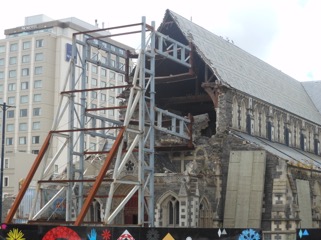 and they had built a ‘transitionary’ Cathedral as a temporary measure whilst they decide what to do. This is the “cardboard” cathedral designed by a Japanese architect, Shigeru Ban, who specialises in emergency buildings after natural disasters. Materials used include cardboard tubes, timber, which runs through the centres of the tubes and steel. The roof is polycarbon and is held up by eight shipping containers which form the inside form the offices for the Cathedral. Amazing!  The containers are along the bottom sides 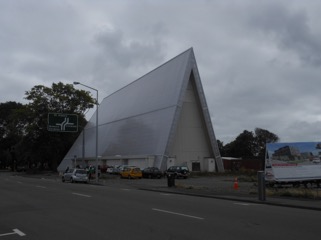 the tubes that from the sloping walls are the cardboard tubes   the acoustics were good. There is now a major argument both within the church and with insurers as to what to do with the old Cathedral. The die-hards want it rebuilt exactly as it was and others want a newer, fit for purpose in the modern day, Cathedral. The insurers are saying that they will rebuild but will not rebuild to the new construction specification required to prevent further earthquake damage. The insurance argument rages all over the City the legal challenges and court cases are delaying reconstruction. Meanwhile a temporary shopping centre has been created in order to encourage people to return to the City centre—this is known ‘container city’. The shops are all containers (perhaps this where the idea of using sea containers to repair the Dawlish sea wall came from?)  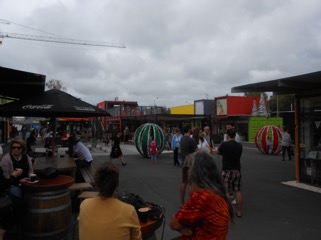 Meanwhile Christchurch City Council through the established body CERA (Canterbury Earthquake Recovery Authority) have agreed a redevelopment plan for the city and it is hoped that this will be implemented and construction completed by 2019. Although the development control body have compulsory purchase powers it is difficult to see how this timetable will be met especially wlth all the legal wrangling. We left Christchurch and drove out onto the Bank Peninsula so named because Captain Cook sailed there with Joseph Banks. Diamond Harbour was our first port of call; a small community immediately opposite Lyttleton Harbour. There was a ferry with half hourly ten minute crossings to the port of Lyttleton——this port had also been severely damaged by the earthquake.   and the on round the peninsula towards Akaroa where we are spending Christmas. At one stage we climbed up the mountain road and when we reached the summit the view across to Akaroa received yet another “wow” and a stop for a photo. Unfortunately the blog photos does not give the subject matter justice due to the reduced pixels to enable them to be sent by internet. Even the full pixel photos do not give the real wow factor that the naked eye sees. 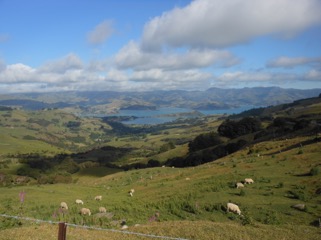 We passed an interesting place to stay——a grain silo!!  The silos have been built as self contained units for two people. Sitting room downstairs, double bedroom with balcony, shower and loo and the top hatch (yellow in the photo) opens up to give you a view of the stars!   A very clever concept! We found a spot to stop for the night and went to sleep with this view on one side across the lake 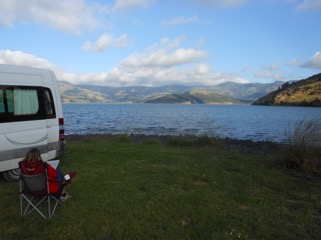 and awoke with this view on the other side——ewes and lambs being moved down the road 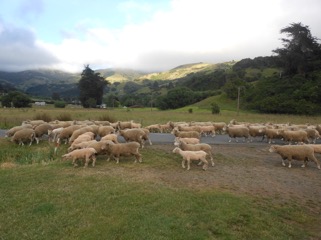 Mark talked to the farmer to ask about the lambs which had all been shorn. Apparently this is to prevent fly strike which is caused by a little Australian (!) fly that is prevalent where there are manuka bushes on the hill. The lamb’s fleece is exported to England and bought by a company called Kamira (?) and is used in cloth making. We wish all our blog readers a very Happy Christmas and New Year whether you be on land or at sea or perhaps even in a Mighty! |